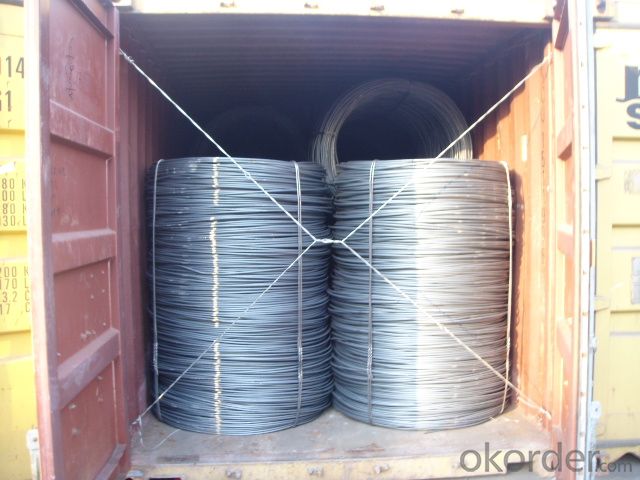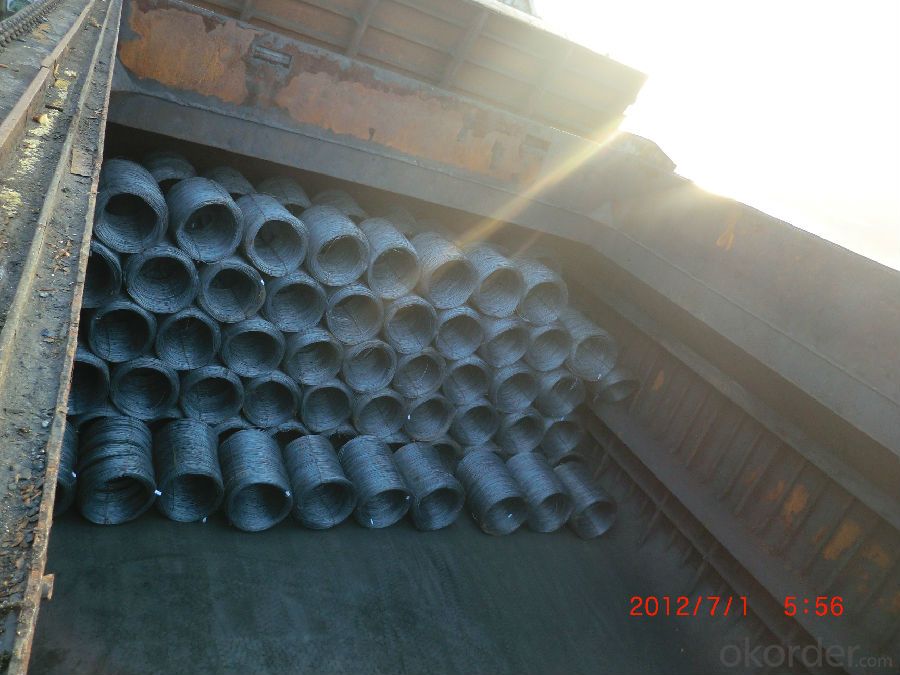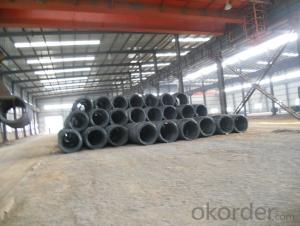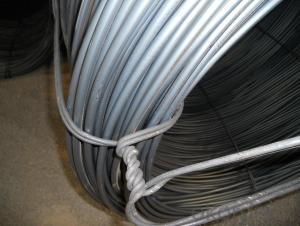ASTM Steel Wire Rods SAE1008,SAE1010, SAE1012
- Loading Port:
- Shanghai
- Payment Terms:
- TT or LC
- Min Order Qty:
- 25 m.t.
- Supply Capability:
- 200000 m.t./month
OKorder Service Pledge
OKorder Financial Service
You Might Also Like
Product Description:
OKorder is offering ASTM Steel Wire Rods SAE1008,SAE1010, SAE1012 at great prices with worldwide shipping. Our supplier is a world-class manufacturer of steel, with our products utilized the world over. OKorder annually supplies products to European, North American and Asian markets. We provide quotations within 24 hours of receiving an inquiry and guarantee competitive prices.
Product Applications:
After hot-rolled the products shaped into coil and delivery as finished product, including round, square,rectangular, hexagonal and so on. Since most of the products are round, it is generally called wire rod. Carbon steel wire rod is widely used in construction and manufacturing. Carbon steel wire rod is mainly used for reinforcement of reinforced concrete and welded structure or reprocessed (roberts , nail, etc.) materials, especially used to produce wire drawing, welding electrode, nails, spring, electronic, precise machinery parts and so on.
Product Advantages:
OKorder's ASTM Steel Wire Rods SAE1008,SAE1010, SAE1012 are durable, strong, and resist corrosion.
Main Product Features:
· Premium quality
· Prompt delivery & seaworthy packing (30 days after receiving deposit)
· Corrosion resistance
· Can be recycled and reused
· Mill test certification
· Professional Service
· Competitive pricing
Product Specifications:
ASTM Steel Wire Rods SAE1008,SAE1010, SAE1012
Grade: SAE1006-SAE1018
Certificates: ISO, SGS, BV, CIQ
Packaging: Export packing, nude packing, in coils
Grade | Chemical Composition (%) | |||||
C | Mn | S | P | Si | B | |
SAE1008B | 0.10max | 0.32max | 0.045max | 0.040max | 0.30max | 0.0008min |
Mechanical properties | ||||||
Yield strength(N/mm2) | Tensile strength(N/mm2) | Elongation (%) | ||||
≥195 | 350-380 | ≥32 | ||||
FAQ:
Q1: Why buy Materials & Equipment from OKorder.com?
A1: All products offered byOKorder.com are carefully selected from China's most reliable manufacturing enterprises. Through its ISO certifications, OKorder.com adheres to the highest standards and a commitment to supply chain safety and customer satisfaction.
Q2: How do we guarantee the quality of our products?
A2: We have established an advanced quality management system which conducts strict quality tests at every step, from raw materials to the final product. At the same time, we provide extensive follow-up service assurances as required.
Q3: The products are invoicing on theoritical weight or on actual weight?
A3: Usually, on actual weight.


- Q:How is steel wire rod used in the manufacturing of wire forms for lighting fixtures?
- Steel wire rod is used in the manufacturing of wire forms for lighting fixtures as it serves as the primary raw material for creating various wire shapes and designs. The wire rod provides the necessary strength, durability, and malleability required for bending, twisting, and shaping the wire into the desired form. It is commonly used to create intricate structures such as lampshades, frames, and decorative elements, ensuring that the lighting fixtures are sturdy and aesthetically pleasing.
- Q:How is steel wire rod used in the manufacturing of wire forms for automotive seat belts?
- Steel wire rod is a crucial component in the manufacturing of wire forms for automotive seat belts. The wire rod is first processed and shaped into the required form using advanced machinery and techniques. This form is then utilized to create the intricate design and structure of the seat belt, ensuring its strength and durability. Steel wire rod is chosen for this purpose due to its exceptional strength and high tensile properties. It provides the necessary resilience and flexibility required to withstand the stresses and forces experienced by seat belts during normal usage and potential accidents. Once the wire forms are created, they are further processed and treated to enhance their performance characteristics. This may involve heat treatment, galvanization, or coating processes to improve their resistance to corrosion, wear, and tear. The wire forms are then assembled with other components, such as buckles and retractors, to complete the seat belt assembly. The strength and quality of the steel wire rod used significantly contribute to the overall safety and reliability of the seat belt system. In conclusion, steel wire rod plays a vital role in the manufacturing of wire forms for automotive seat belts. It provides the necessary strength, durability, and flexibility to ensure the safety and performance of these critical safety devices.
- Q:What are the main factors influencing the choice of steel wire rod production process?
- The choice of steel wire rod production process is influenced by several key factors. Firstly, the quality requirements of the final product play a crucial role. Different production processes have varying capabilities to produce steel wire rods with specific properties such as strength, ductility, and surface finish. The desired characteristics of the wire rod will dictate the choice of production process. Secondly, the cost-effectiveness of the production process is an important consideration. Factors such as energy consumption, raw material utilization, and labor requirements can significantly impact the overall cost of production. Different processes may have varying efficiencies and costs, and these factors need to be evaluated to ensure the most economical choice. Furthermore, the availability and cost of raw materials also influence the selection of the production process. Steel wire rod can be produced from different types of steel, such as carbon steel, alloy steel, or stainless steel. The choice of raw material depends on factors such as required mechanical properties, availability, and cost. The production process must be compatible with the selected raw material. Another factor influencing the choice is the production capacity and scalability of the process. Some processes may be more suitable for small-scale production, while others are better suited for large-scale manufacturing. The desired production volume and scalability requirements need to be considered to ensure the chosen process can meet the production demands. Additionally, environmental considerations can also impact the choice of production process. Some processes may generate more waste or emit higher levels of pollutants compared to others. Companies may prioritize sustainable and environmentally friendly production methods, leading them to select a process that minimizes environmental impact. Overall, the main factors influencing the choice of steel wire rod production process are the desired product quality, cost-effectiveness, availability and cost of raw materials, production capacity and scalability, and environmental considerations. A careful evaluation of these factors is necessary to select the most suitable production process for a specific application.
- Q:What are the major challenges faced by the steel wire rod industry?
- Some major challenges faced by the steel wire rod industry include fluctuating raw material prices, intense competition from alternative materials, such as aluminum and composites, and the need to constantly innovate and adapt to changing market demands. Additionally, the industry often faces regulatory and environmental challenges related to emissions and waste management.
- Q:What are the common welding techniques for steel wire rod?
- There are several common welding techniques used for steel wire rods, depending on the specific application and desired outcome. Some of the most commonly used techniques include: 1. Gas Metal Arc Welding (GMAW): Also known as MIG (Metal Inert Gas) welding, this technique uses a consumable wire electrode and a shielding gas to create a weld. GMAW is commonly used for welding steel wire rods due to its versatility, ease of use, and ability to produce high-quality welds. 2. Gas Tungsten Arc Welding (GTAW): Also known as TIG (Tungsten Inert Gas) welding, this technique uses a non-consumable tungsten electrode and a shielding gas to create a weld. GTAW is often used for precision welding applications where a high level of control and a clean, aesthetically pleasing weld are required. 3. Flux-Cored Arc Welding (FCAW): This technique uses a tubular wire electrode with a flux-filled core. The flux provides a shielding gas and helps remove impurities from the weld zone. FCAW is commonly used for welding steel wire rods in outdoor or windy environments where the shielding gas from GMAW or GTAW may be compromised. 4. Shielded Metal Arc Welding (SMAW): Also known as stick welding, this technique uses a consumable electrode coated in flux. The flux creates a shielding gas and helps remove impurities from the weld zone. SMAW is a versatile and portable welding technique commonly used for steel wire rods in various applications. 5. Resistance Welding: This technique involves passing an electric current through the steel wire rods to create resistance and generate heat, which fuses the materials together. Resistance welding is commonly used for high-speed production welding of steel wire rods, such as in the manufacturing of wire mesh or fences. It is important to select the appropriate welding technique based on factors such as the type of steel wire rod, the desired strength and quality of the weld, the welding environment, and the available equipment and resources.
- Q:How is steel wire rod used in the production of wire ropes for ski lifts?
- Steel wire rod is an essential component in the production of wire ropes for ski lifts. The wire rod serves as the raw material from which the wire ropes are manufactured. To begin with, the steel wire rod is carefully selected for its specific properties, such as strength, durability, and flexibility. These characteristics are crucial for ensuring the wire ropes can withstand the heavy loads and constant usage associated with ski lift operations. Once the appropriate steel wire rod is obtained, it undergoes a series of processes to transform it into wire ropes. The wire rod is first cleaned and then heated to a specific temperature to improve its malleability. It is then passed through a series of dies to gradually reduce its diameter and shape it into a continuous length of wire. Next, the individual wires are twisted together to form strands. This twisting process, known as stranding, can vary in configuration depending on the desired strength and flexibility of the wire rope. The strands are then compacted and laid together around a central core, forming the final wire rope structure. The use of steel wire rod in the production of wire ropes for ski lifts offers several advantages. Firstly, steel is known for its high tensile strength, allowing the wire ropes to support heavy loads and provide a safe transportation system for skiers. Additionally, the durability of steel ensures that the wire ropes can withstand the harsh weather conditions and constant exposure to extreme temperatures on mountain slopes. Furthermore, the flexibility of steel wire rod allows the wire ropes to bend and conform to the pulleys and sheaves used in ski lift systems, ensuring smooth and reliable operation. This flexibility is vital in preventing any sudden failure or damage to the wire ropes during their continuous usage. In conclusion, the use of steel wire rod in the production of wire ropes for ski lifts is paramount to ensure the safety, reliability, and durability of these transportation systems. The properties of steel, such as its strength and flexibility, make it an ideal material for constructing wire ropes that can withstand the demanding conditions of ski lift operations.
- Q:How are steel wire rods used in the production of fencing?
- The production of fencing involves the use of steel wire rods in multiple ways. Initially, these rods are the primary material for manufacturing the wires that compose the fencing structure. They are typically made from high-quality steel, which imparts strength and durability to the fencing. To initiate the production process, the steel wire rods undergo an initial cleaning and coating to prevent rusting and corrosion. Next, they are passed through a series of machines that draw them down to the desired thickness and shape. This drawing process enhances the wire's tensile strength, making it suitable for fencing purposes. Once the wire has been drawn, it undergoes further processing to create various types of fencing products. For instance, some wire rods are twisted or braided together to form chain-link fencing. These interwoven wires create a mesh-like pattern commonly used to secure residential or commercial properties. Typically, the wire rods used for chain-link fencing are galvanized or coated with PVC to increase their longevity and resistance to weathering. In addition to chain-link fencing, steel wire rods are also utilized in the production of welded wire mesh fencing. This type of fencing consists of a grid-like pattern formed by welding intersecting steel wires together. The wire rods used for welded wire mesh fencing are usually galvanized or coated with zinc to prevent rust and corrosion. In summary, steel wire rods are vital in the production of fencing as they provide the raw material necessary to create sturdy, durable, and secure fences. Their versatility allows for the manufacturing of various types of fencing, catering to different needs and requirements in both residential and commercial settings.
- Q:What are the factors affecting the price of steel wire rods?
- There are several factors that can affect the price of steel wire rods. These include the cost of raw materials such as iron ore and scrap metal, the demand and supply dynamics in the market, fluctuations in currency exchange rates, government policies and regulations, and the overall economic conditions. Additionally, factors such as production costs, energy prices, and transportation costs can also impact the price of steel wire rods.
- Q:How is steel wire rod used in the manufacturing of suspension bridges?
- Steel wire rod is a crucial component in the manufacturing of suspension bridges. It is primarily used in the construction of the main cables, which are the most critical load-bearing elements of these bridges. The main cables of suspension bridges are responsible for supporting the weight of the bridge deck and transferring the load to the towers or piers. The steel wire rod is first formed into individual strands, typically ranging from hundreds to thousands of wires per strand, depending on the size and load capacity of the bridge. These strands are then tightly wrapped around a central core to form the main cable. The strength and durability of the steel wire rod make it an ideal material for this application, as it can withstand the immense tension and load placed on the bridge. In addition to the main cables, steel wire rod may also be used in other components of suspension bridges, such as the hangers and suspenders. These elements connect the bridge deck to the main cables and help distribute the load evenly across the entire structure. Steel wire rod is chosen for these applications due to its high tensile strength, excellent flexibility, and resistance to corrosion. Overall, steel wire rod plays a vital role in the manufacturing of suspension bridges by providing the necessary strength, durability, and flexibility required to support the structure and ensure its safe and efficient operation.
- Q:What are the main factors influencing the choice of steel wire rod order warranty claims process?
- The choice of the warranty claims process for steel wire rod orders can vary depending on several factors. Firstly, the quality of the wire rod plays a significant role in determining how often and how straightforward the warranty claims process will be. If the wire rod meets the required standards and is of high quality, there may be fewer claims and a simpler process. Conversely, if the wire rod has inherent flaws or defects, there is a higher likelihood of warranty claims, resulting in a more complex process. Secondly, the terms and conditions of the warranty provided by the supplier or manufacturer can greatly impact the choice of the warranty claims process. The duration, coverage, and any limitations or exclusions of the warranty can influence decision-making. A comprehensive warranty with a reputable supplier can instill confidence in the buyer, making them more likely to choose that specific claims process. Additionally, the availability and efficiency of customer support and after-sales service are crucial factors in deciding the warranty claims process. Responsive and prompt customer support can expedite the claims process, provide guidance, and address any concerns or queries from the buyer. This level of support significantly influences the choice of the warranty claims process, ensuring a smoother and more satisfactory experience. Furthermore, the reputation and track record of the supplier or manufacturer also impact decision-making. Buyers are more likely to select a warranty claims process from a trustworthy supplier with a history of promptly and fairly honoring warranty obligations. This factor provides peace of mind and increases confidence in choosing a particular claims process. Lastly, the cost-effectiveness and convenience of the warranty claims process can play a role in the decision. If the process is affordable and convenient for the buyer, they may be more inclined to choose that specific claims process. This includes factors such as the ease of filing a claim, the time taken for resolution, and any associated costs or deductibles. Overall, the key factors influencing the choice of warranty claims process for steel wire rod orders are the quality of the product, the terms and conditions of the warranty, the availability of customer support, the reputation of the supplier, and the cost-effectiveness and convenience of the process.
1. Manufacturer Overview |
|
|---|---|
| Location | |
| Year Established | |
| Annual Output Value | |
| Main Markets | |
| Company Certifications | |
2. Manufacturer Certificates |
|
|---|---|
| a) Certification Name | |
| Range | |
| Reference | |
| Validity Period | |
3. Manufacturer Capability |
|
|---|---|
| a)Trade Capacity | |
| Nearest Port | |
| Export Percentage | |
| No.of Employees in Trade Department | |
| Language Spoken: | |
| b)Factory Information | |
| Factory Size: | |
| No. of Production Lines | |
| Contract Manufacturing | |
| Product Price Range | |
Send your message to us
ASTM Steel Wire Rods SAE1008,SAE1010, SAE1012
- Loading Port:
- Shanghai
- Payment Terms:
- TT or LC
- Min Order Qty:
- 25 m.t.
- Supply Capability:
- 200000 m.t./month
OKorder Service Pledge
OKorder Financial Service
Similar products
New products
Hot products
Related keywords




























